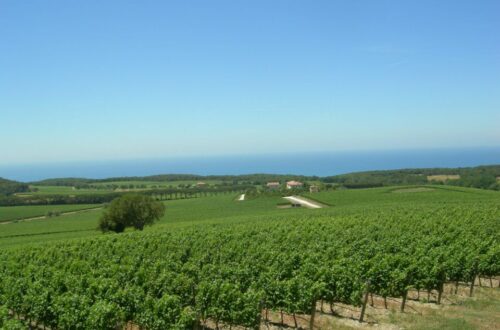Table of Contents
Introduction
Few wines carry the soul of Tuscany like Vin Santo del Chianti DOC. This golden-hued dessert wine—steeped in centuries of tradition—embodies patience, craftsmanship, and the art of appassimento. Often sipped alongside cantucci almond biscuits, Vin Santo is more than just a drink; it’s a ritual of hospitality and celebration.
History & DOC Status
Vin Santo’s origins date back to the Middle Ages, with legends linking its name to miraculous healings and sacred blessings. Its DOC status, awarded in 1997, recognizes both its deep cultural roots and the strict production rules that safeguard its authenticity.
Chianti Terroir & Climate
The Chianti DOC zone—stretching across much of Tuscany—offers the ideal conditions for Vin Santo production. Warm, dry summers allow grapes to ripen fully, while crisp autumn air encourages slow drying during the appassimento phase. Subzones such as Chianti Classico and Rufina contribute subtle differences in aroma and structure.
Grape Varieties & Styles
Vin Santo del Chianti DOC is traditionally made from Trebbiano Toscano and Malvasia Bianca Lunga, though Sangiovese may appear in the rosé-like Occhio di Pernice style. Styles range from lusciously sweet to drier, nuttier expressions.
Winemaking & Regulations
The hallmark of Vin Santo is the appassimento method—grapes are harvested in September, then hung or laid on mats to dry for months, concentrating sugars and flavors. Fermentation takes place in small caratelli barrels, often with natural yeasts. By DOC law, aging must be at least three years in wood, with many producers extending this to a decade for complexity.
Tasting Notes & Aromatics
- Color: Deep amber to golden hues
- Aromas: Honey, dried apricot, toasted almonds, fig, caramel
- Palate: Rich and velvety, with balancing acidity that keeps sweetness lively
- Finish: Long and warming, with echoes of spice and dried fruit
How to Serve & Pair Vin Santo
Serve slightly chilled (12–14°C). Traditional pairing is with Tuscan cantucci, but it also pairs beautifully with:
- Aged cheeses like pecorino toscano
- Foie gras or pâté
- Fruit tarts, biscotti, and nut-based desserts
Where to Buy & Pricing
Vin Santo del Chianti ranges from €15–€60 per half-bottle, with rare vintages fetching more. Look for reputable producers in wine shops, Italian specialty stores, and online marketplaces.
Recommended Producers
- Avignonesi
- Castello di Ama
- Isole e Olena
- Badia a Coltibuono
Vin Santo vs. Passito – Key Differences
While both are made with dried grapes, Vin Santo relies on long aging in small barrels, developing oxidative notes, while Passito styles (like Recioto) are typically fruitier and aged for shorter periods.
Cultural Notes & Traditions
In Tuscany, offering a glass of Vin Santo is a gesture of warmth and respect. In rural communities, it was traditionally reserved for holidays, weddings, and visits from honored guests.
FAQ
Q: Is Vin Santo always sweet?
A: Most styles are sweet, but some producers make dry or abboccato versions.
Q: How long does Vin Santo last once opened?
A: Due to its high sugar and alcohol, it can last several weeks if sealed and stored in a cool place.
Q: Can I age Vin Santo at home?
A: Yes, many improve with bottle age, developing deeper nutty and caramelized flavors.
Call to Action
Let Vin Santo share Tuscany’s timeless sweetness in your glass. Find a bottle of Vin Santo del Chianti DOC or plan a tasting journey through Chianti’s sun-kissed cellars. Share your story with #DrinkItalianVinSanto and join our global community of cultural wine lovers.


